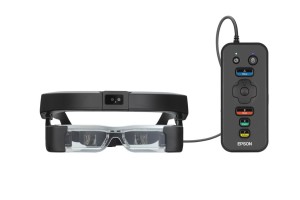 It’s far from impossible that Google, which did so much to plant the idea of a techie visor in the world’s brain, will wind up seriously trailing the market it helped popularize. There are continuing slow leaks about the Enterprise Edition of Google Glass, but none of them really comes close products like Epson’s Moverio BT-2000.
It’s far from impossible that Google, which did so much to plant the idea of a techie visor in the world’s brain, will wind up seriously trailing the market it helped popularize. There are continuing slow leaks about the Enterprise Edition of Google Glass, but none of them really comes close products like Epson’s Moverio BT-2000.
The Moverios were never anything you’d wear on the street. They have heavy Coke-bottle looking lenses, with waveguide video built into both lenses, and were built for enterprises: energy, warehousing, field service and the like. The initial BT-200 was good enough that it became a common development platform for most of the augmented reality crowd.
With the BT-2000, Epson is raising the game. Rather than typical ever-smaller efforts in the consumer market, Epson actually made its new glasses bigger. The battery pack is larger, with two batteries. so it can power the visor for most of a work day. The control module is bigger, so it can be operated by workers wearing gloves. And Epson added a headband, designed to fit over a hardhat, that includes dual 5MP cameras to allow for depth perception and a sophisticated inertial motion sensor to help locate wearers in places where GPS is either unavailable, unreliable or imprecise.
The latest word on Google Glass is that the enterprise versions will look very much like the Explorer edition, although a little heavier and more rugged, and foldable. It will still, apparently, have just the one video element in the top right of the right lens.
There’s been no word about when Google will ship or what Glass will cost. Epson says it hopes to start shipping the BT-2000 by the end of the year; company reps say most of the work remaining is developing SDKs for the camera and positioning unit, and getting early units to third-party middleware shops. Pricing is expected between $2500 and $5000, depending on distribution channel and quantity.